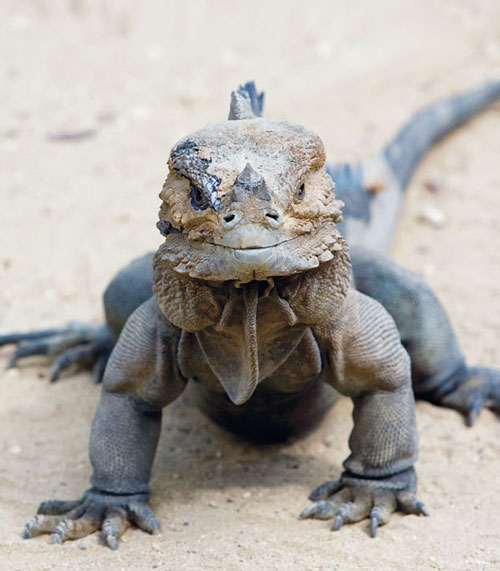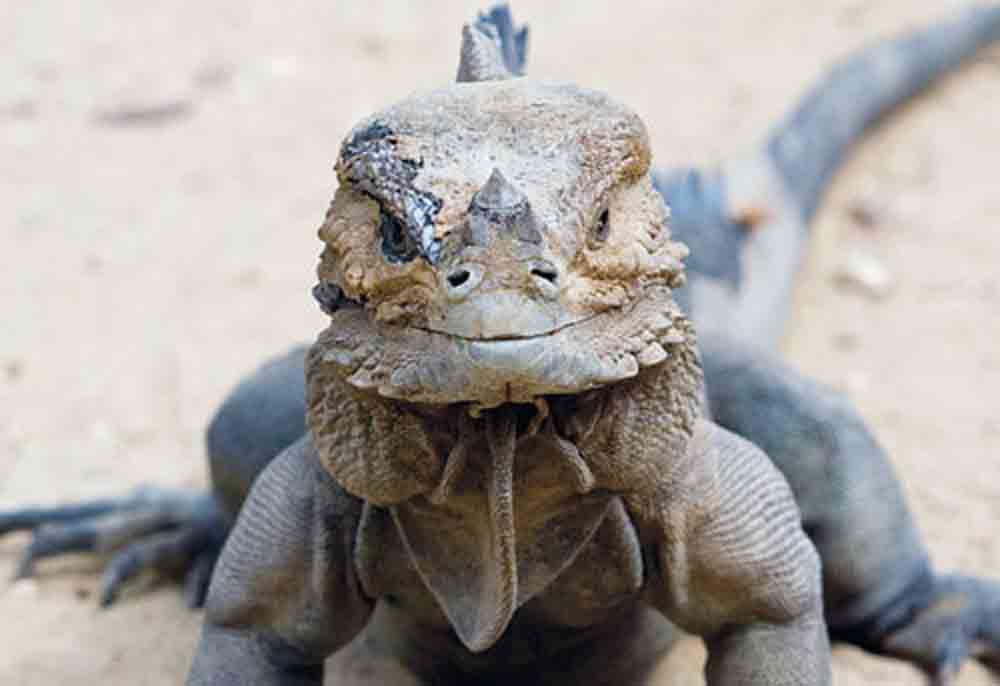Rhinoceros iguana information and care.
Light and Heat Notes
Proper lighting that simulates natural sunlight and the right temperature control are crucial for the rhinoceros iguana. Too often the cost of good lighting is circumvented by the use of substandard products or, worse, by eliminating some lighting altogether. Don’t economize!

Photo Credit: John Binn.
Rhinoceros iguana
Three primary lamps are usually needed to fill the rhino iguana’s basic lighting requirements: color-corrective, basking and UVB. Lamp wattages depend on enclosure size, but all lamps come in various wattages to cover most needs.
Please note that the type and number of lamps required is subject to variability. In some cases the basking lamp can be eliminated if the UVB lamp produces sufficient heat for basking. Or the color-corrective lamp can be eliminated, depending on enclosure size, if you’re using a UVB metal halide lamp. But this lamp must meet the following specifications. A metal halide with .5 percent UVB, 11 percent UVA and 88.5 percent visible light is as close as you’ll ever get to the solar proportions. It also must produce 70,000 lux (about what you see at 10 a.m.) at a distance of 11½ inches. The brighter and more complete light spectrum can have a direct effect on the reptiles’ specific and paraspecific immune system. I use the new Mega-Ray Metal Halide UVB Lamp. Larger enclosures may require additional color-corrective lamps or fluorescents.
The purpose of color-corrective lighting is to provide bright, white light (natural daylight) within a range of about 30,000 to 80,000 lux with a color temperature range of 4000 to 6000 Kelvin (the higher the better). Not recommended are household incandescent light bulbs that produce yellowish light (2800 to 3300 K). I believe the best lamps for color-corrective lighting are metal halides (HQI color-corrected type), and/or one with 5000 to 6000 K that has compact or linear fluorescent tubes.
For rhinos’ and other Cyclura iguanas’ UVB requirements, I use the Mega-Ray UVB lamp by Reptile UV. These lamps produce sufficient levels of UVB (290 to 305 nanometers). Always follow the manufacturer’s guidelines when setting up these lights.
Basking lamp options include halogen, mercury vapor and others. Selection and type is based on diameter of the basking area, its distance from the basking fixture, and wattage necessary to achieve the correct basking temperature.
A thermostat-controlled heat lamp may also be required to maintain the nighttime ambient temperature or to stabilize daytime ambient temperatures in large enclosures. I use the Mega-Ray 60-Watt Lightless Infrared Heat Projector, which projects more heat than a traditional 100-watt ceramic heat emitter.
Place the basking area at the far end of the iguana’s enclosure to allow for a temperature gradient (hot to cool zone). Depending on the UVB and basking lamp configuration, place the fixtures with reflectors next to one another directly above the basking area’s center. Set the UVB lamp at the height recommended by the manufacturer, and adjust the basking lamp’s height to produce a temperature of 106 degrees. It should be configured to create an invisible cone of UVB radiation and heat that is large enough to encompass the rhino’s entire body. A large, flat, smooth fieldstone beneath the lamps works well to radiate heat from below. The periphery around this area should remain clear of objects for one to two feet, so the rhino can select a position for optimal thermoregulation. Adjustable ceiling vents directly above the iguana’s basking zone help to evacuate excess heat, and a small fan could be added to evacuate stale air through clothes-dryer tubing leading to the outside.
The optimal daytime ambient temperature within the enclosure is 81 degrees (with an acceptable range of 75 to 88 degrees). The cool-zone temperature is about 10 degrees less, creating an optimal nighttime temperature of 70 degrees (or a range of 68 to 73 degrees). Rhinos should not be exposed to temperatures below 62 degrees for any length of time.
Enclosure Comforts
Rhino iguanas are creatures of comfort, and their enclosures should offer places to lie down and a retreat to sleep. In the cool zone, the floor should be flat and heat-absorbent.
Place food and water bowls, positioned so they are difficult to overturn, in the cool zone. Substrate is not recommended near any feeding location because rhinos can ingest small amounts of it, which can lead to intestinal impaction. Floor covering used in the enclosure can be newspaper, artificial turf or outdoor carpeting; all are products that are easy to clean and replace. Soil- or bark-based substrates are not recommended for partitioned rooms or indoor enclosures. They can be used outdoors, as long as the feeding area is free of them.
Dietary Requirements
The adult rhino iguana diet shown on page 42 meets the lizard’s minimal to optimal nutritional requirements, and it contains a balance of calcium, phosphorous, plant protein and fiber based on the combination of plant foods per serving with a minimum calcium-phosphorous ratio of 2-to-1 and a plant protein level of 9 to 12.4 percent. Correct environmental temperatures are crucial to ensure proper digestion.
Captive Cyclura species tend to have limited opportunities to exercise. Always couple their diet with an exercise regimen to expend calories, build muscle and improve gut motility. Monitor the animal’s weight and health regularly, and modify the diet if problems arise. Suggested serving amounts will vary depending on the size of the iguana, but they should not lead to obesity. Take your rhino to a veterinarian regularly for health checkups and to have fecal samples analyzed.
Diets evolve as new information is acquired, and this diet is no different. Existing research clearly indicates that rhinos are almost exclusively herbivores that infrequently consume small amounts of animal matter. Ingested animal matter results in excessive levels of protein, which can cause obesity and renal disease. This leads to excessive fat pads lining the abdominal cavity and hepatic lipidosis (fatty liver disease). A high-protein diet also damages the lizards’ kidneys over time and can cause chronic renal failure. Because organ damage is permanent, animal matter is not considered in this diet.
Avoid using plants with no nutritional value or those containing excessive amounts of phosphorus, oxalates (which inhibit calcium binding) or goitrogens (which suppress thyroid function). Spinach, cabbages, broccoli, Brussels sprouts, corn, celery and lettuces fall into one of these categories to avoid.
Based on the diet and lighting recommendations in this feature, we dust CaribSea’s Blue Iguana Cal-Stron calcium over the diet ingredients before mixing them one to two times per week (two to three times for juveniles). For vitamins we dust Rep-Cal Herptivite over diet ingredients before mixing them every two weeks (every week for juveniles). Dusting is based on the manufacturer’s recommendations.
Calcium and vitamins are best prescribed by a qualified Cyclura vet who can analyze the iguana’s health, diet and lighting to recommend an appropriate amount based upon the lizard’s needs. Many lizardkeepers dust with supplements too often or too little. Having a veterinarian’s input is essential to the animal’s health.
Ingredients and Preparation
Wash all food before preparation. All plant material must be free of pesticides and fertilizers. Avoid nursery plants; they are grown with pesticides not intended for consumption, and these cannot be washed off. Remove seeds or pits. After food is processed, mix in a large container until all the ingredients are well-distributed. Mixing helps discourage the iguana from picking out favorite items and leaving the rest.
Greens
Staple: Dandelion*, collard greens, mustard greens, turnip greens *Note: Dandelion is required but can be temporarily replaced (for one to two weeks) with any one of the other staple greens. Turnip is interchangeable with collard and mustard greens.
Garnish: Escarole, watercress, endive, chicory
Occasional: Chard, kale, bok choy, cilantro, parsley
Diet Preparation: Cut thin strips one-fourth inch wide. Cut long strips crosswise every 2 to 3 inches for adults and every 1 inch for juveniles.
Vegetables
Staple: Green beans, snap peas, okra, parsnip, yucca root, bell peppers
Occasional: Carrots, beets, sweet potatoes
Diet Preparation: Chop and then shred vegetables in a food processor.
Squash
Staple: Acorn, butternut, kabocha, pumpkin, spaghetti squash
Garnish: Banana, delicata, Hubbard, turgan, crookneck and yellow squash
Occasional: Zucchini
Diet Preparation: Skin and remove seeds from all squash items before feeding. Using a food processor, grate all squash items.
Fruits
Staple: Figs, dates, papaya, mango, cactus pads (prickly pear), cactus fruit (tuna fruit, much like prickly pear)
Garnish: Blueberries, raspberries, kiwi, acai berry
Occasional: Apples, bananas, blackberries, strawberries, grapes, nectarines, pears, cantaloupe, honeydew, watermelon
Diet Preparation: Using a food processor or sharp knife, finely chop all fruit items; apples can be shredded.
Fiber
Sources: A high-quality, natural adult or juvenile food pellet without color dyes, such as Zoo Med and OxBow products made for iguanas. Alfalfa powder, leaf teas or pellets only; no loose or compressed hay.
Diet Preparation: Mix fiber and water (two-parts fiber to one-part water). If required, after the initial feeding, mist the food bowl to prevent excessive drying.
|
|
||||||||
|
Ingredient
|
Weight
|
Mon
|
Tue
|
Wed
|
Thur
|
Fri
|
Sat
|
Sun
|
| Dandelion | 100 grams |
|
|
|
|
|
|
|
| Collard Greens | 100 grams |
|
|
|
|
|
|
|
| Mustard Green | 100 grams |
|
|
|
|
|
|
|
| Vegetable1 | 10 grams |
|
|
|
|
|||
| Squash1 | 10 grams |
|
|
|
|
|||
| Fruit1 | 5 grams |
|
|
|
||||
| Fiber2 | 30 grams |
|
|
|
||||
| 1. Select one or a combination from the ingredient list category for each serving weight. 2. Fiber’s serving weight is before adding water to moisten. |
||||||||
A special thanks to A.J. Gutman, Juliann Sweet, Melissa Kaplan, Jose Ottenwalder, Ernst Rupp, Thomas Wiewandt, Bob Powell, Bob MacCargar, Francis Baines and Sandy Binns for their efforts with this feature.


